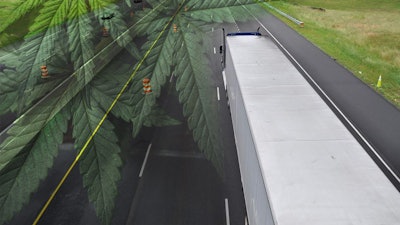 The changing landscape nationally regarding marijuana laws could soon present conflicts in the trucking industry around employee-employer relations, says attorney Adam Dolan. However, a group consisting of major carriers refutes that point, and the U.S. DOT is advancing rules that tighten drug screening policies in the trucking industry.
The changing landscape nationally regarding marijuana laws could soon present conflicts in the trucking industry around employee-employer relations, says attorney Adam Dolan. However, a group consisting of major carriers refutes that point, and the U.S. DOT is advancing rules that tighten drug screening policies in the trucking industry.Could the trucking industry, long-plagued with high driver turnover and a need for new driver entrants, be missing out on a swath of potential drivers due to its strict no-marijuana-use policies?
It’s an idea open to debate, says attorney Adam Dolan, chair of the cannabis law group for the firm Goldberg Segalla, where he’s also a partner of the trucking and automotive group.
“There’s a societal shift in the way we view cannabis use,” says Dolan, particularly around the use of marijuana for medical purposes. And it’s an issue he contends the trucking industry will likely need to confront in light of the perceived shortage of available truck drivers and, increasingly, as state marijuana laws change.
“By saying no person can use marijuana, even if they have a medical recommendation for it, you’re cutting yourself off from such a large pool of applicants that could provide the industry with much-needed manpower,” Dolan says. Fleets, and the U.S. Department of Transportation, need to “accept the fact that this issue is not going away,” he says. “You’re going to start running into problems.”
If a driver is using marijuana — while not driving — under a doctor’s recommendation to treat a serious illness or as a treatment for recovery from a more serious drug addiction and is banned from driving, he or she could make a discrimination claim under the Americans with Disabilities Act (ADA), says Dolan. That scenario could become even more legitimate should the federal government remove cannabis from its current listing as a Schedule I drug – the most tightly regulated drugs and those perceived to be the most dangerous.
The U.S. Food and Drug Administration has faced increased pressure in recent years to remove cannabis from its current listing as a Schedule I drug and reclassify it. Schedule I drugs include, among many others, heroin, ecstasy and LSD. In that sense, marijuana is classified by the federal government as more dangerous than cocaine, methamphetamine, opium and fentanyl – all of which are Schedule II drugs. Last year, the FDA sought public comments on whether it should reclassify cannabis, opening the door to altering its schedule status.
Dolan says such a reclassification could pave the way for marijuana to be treated more like a prescription medication, such as Xanax and Valium – or even Robitussin, which is classified as a Schedule V drug. If cannabis is recognized as having medical value by the federal government, drivers using the drug under a doctor’s recommendation for medicinal purposes could push back on DOT and fleet policies via ADA, says Dolan.
For example, a fleet can’t fire or terminate a driver for having a prescription for and using pain medication or anti-depressants – many of which fall under FDA scheduled drugs listings.
If DOT regs changed, would you hire a driver who tested positive for marijuana use?
*based on CCJ polling in July, with 540 respondents.
Even for drivers who choose to use “adult-use cannabis,” says Dolan, referring to cannabis legalized for purposes beyond medicinal, greater pushback against strict no-cannabis policies could come if marijuana is reclassified by the federal government. “Let’s say it gets to the point where marijuana is a Schedule V drug and you can get it like you get alcohol. You can’t ban a person from being a driver if they consume a beer or have a shot of tequila. So what happens then? Do you ban them for using marijuana? Or fire them?” he asks. “You have to ask if you’re opening yourself up for litigation.”
DOT has remained adamant over the past decade that marijuana remains off-limits for truck drivers, just as many states have opened the door to full legalization.
In fact, DOT – under directives from Congress – is moving toward more stringent requirements for screening drivers for drug use and sidelining those who fail drug tests, not only for marijuana but for all drugs prohibited for truck operators. The Commercial Driver’s License Drug and Alcohol Clearinghouse regulation slated to take effect in January 2020 will keep a database of drivers who’ve failed a drug test, whether for marijuana or for other drugs. Another looming federal rule will allow carriers to use hair sample testing in lieu of urine analysis, with the general premise being that hair testing is a better indicator of prior drug use than urine sample testing.
Likewise, a coalition of some of the country’s largest and more influential carriers, the Trucking Alliance, is adamant that the industry needs to bolster its ability to test drivers for prior drug use and boot those that fail drug tests, including those that fail for marijuana use. The group has been pressing DOT officials to finalize standards to allow hair sample testing to satisfy fleets’ drug-screening requirements of drivers.
Lane Kidd, the Trucking Alliance’s director and spokesperson, rebuts Dolan’s argument that the industry needs to consider opening the door to marijuana users. “I would say the trucking industry has a suitable population to drive its tractor-trailers and will never be in need of tapping into habitual drug users,” says Kidd. “The National Institute of Drug Abuse has a list of attributes that people experience when using marijuana, and those are not attributes we would ever want to see in the cab of a tractor-trailer.”
Kidd equated the issue to airline pilots, which fall under the same drug-testing requirements as truck drivers. “The least we should expect of those workers is that they are drug- and alcohol-free when performing their jobs,” he says.
Just this month, the Trucking Alliance released a study showing that, of 151,662 drivers who were tested for both urine and hair tests, 12,824 failed the hair sample test, while just 949 failed the urine test. Extrapolating on those results, more than 310,000 drivers today “would fail a hair test for illicit drugs and opioids use,” the group concluded.
According to CCJ polling, fleets also seem reluctant to hiring drivers who use marijuana. More than 40 percent of respondents to a recent poll conducted of more than 500 CCJ readers said they would never hire a driver who tested positive for cannabis. Another 23 percent of respondents expressed hesitancy, noting they’d wait on data to come in on drivers who test positive for marijuana before hiring any.
However, 34 percent of respondents said they’d hire a driver that tested positive, so long as they didn’t consume cannabis within eight hours of driving – akin to the laws regarding alcohol use and trucking.












